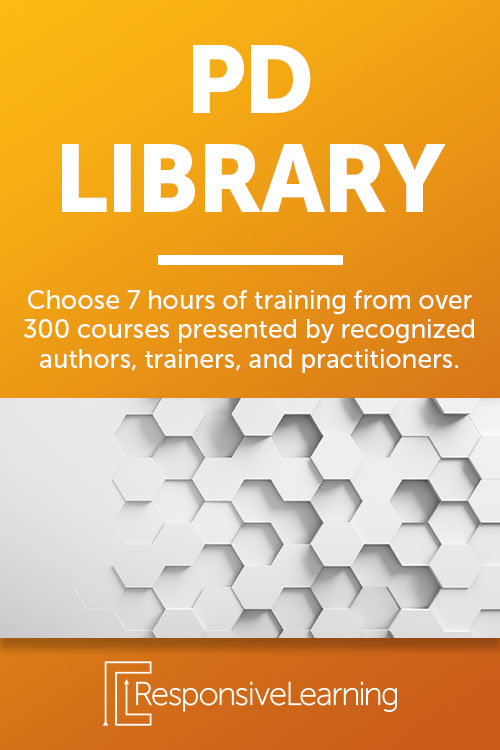Your hard work has finally paid off, and your course is published. It’s out in the world and ready to be shared with educators across the country.
You’re excited to get it into as many hands as possible, but how do you go about promoting it?
At Responsive Learning, we have a marketing strategy to make sure that each course is promoted in the best way possible, but it’s also helpful to know how to promote your course on your own so it’s shared with a wider audience.
Create your website
Creating a website — especially if you don’t feel technically literate — can sound like an overwhelming mountain to climb. But, there are many websites that make the creation process simple, like SquareSpace. Or, if you’re looking for a custom website and want to delegate it to a team of marketing professionals, try our marketing company, 8 Signal!
Having your own, dedicated website is a critical aspect of establishing yourself as a brand. It gives you a slice of digital real estate with your visual brand identifiers (such as your logo, brand colors, fonts, and design) that houses all of your content, such as your blogs, content links, and personal information. It also gives you a great place to link back to when you create social media posts, and saves you from having to repeat the same marketing information over and over.
Here’s the benefit of creating your own website:
The number one benefit your website will create is strong relationships with your audience. A branded website helps you connect with your audience, building their trust as they get to know you, what you’re all about, and the content you create— all in one place! Once your audience is exposed to your website and connects with your message, they’ll bookmark it and come back to engage with the new content you produce.
Plan your social media
Social media can be intimidating if you try to do everything at once.
Instead of getting overwhelmed, make a social media plan.
Each platform has unique benefits and drawbacks, so do a little research and find out which ones are right for you. We recommend only starting with one to two and then building from there.
By creating your own professional social media channels, you can share content that helps other teachers become aware of your material. It’s important to create a different account than your personal one since you want to be seen as a professional who has a business.
Plan out the different platforms you want to use and then make a schedule. It doesn’t have to be complicated, maybe it’s just 15 minutes a day replying to comments and one new post a week.
Here’s the benefit of planning your social media:
Keeping your social media engagement to manageable chunks will help you utilize your time for the most impact and keep you from feeling like all you do is stare at a tiny screen all day. It also gives you the opportunity to look beyond the daily question of, “What do I post today?” and instead lets you ask, “What posts are most valuable to my audience in the big picture?”
Get engaged
Don’t forget that it’s called social media for a reason — it needs to be social. It’s a conversation between you and your followers, yet unfortunately, many people are still using social media like a bulletin board.
Instead, try to approach social media more like a social hub. You might be handing out information, but you also need to be present to answer questions and make comments.
The more social you are on social media, the better it will work for you.
No one likes to feel like they’re constantly being asked to buy something, so make sure that your social media accounts are providing value to your followers, not just being used as an online advertisement. Share blog posts, infographics, and questions with your followers that are relevant to your niche.
Here’s the benefit of engaging with social media:
When content creators are active on social media, you can expect to see greater brand recognition, more engagement from your audience, more eyes on your courses, and a stronger ability to promote your new content because of your engaged customer base. That means when you hit social media to promote your new course, your audience will be excited to hear from you and click the link!
Stay consistent
One thing that will hinder your self-marketing endeavors more than anything else is inconsistency.
Maybe you’ve seen someone with an inconsistent online presence. They’ll spend a few weeks frantically posting, writing, engaging, and have new content each day.
But then suddenly they get burned out and go radio silent. After a while, they’ll start posting lots of new content, and the cycle will begin again.
This kind of engagement hurts your chances of showing up in your followers’ feeds and confuses your audience. With so much content being created every day, yours can get buried if you engage online at random.
So how do you break this cycle? Consistency.
It’s better to have a simple, consistent plan for engaging than it is to ferociously engage for a few weeks and then go MIA. When you start small and stay consistent, people will know what to expect from you.
Creating a plan to market your courses doesn’t have to be complicated. By following these steps, you can jumpstart your professional development business and start sharing your passion for education with the world.
We’re here to help you find success in your professional development business. Contact Responsive Learning for more guidance and help in self-marketing.

